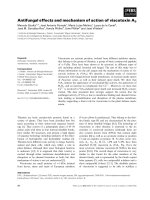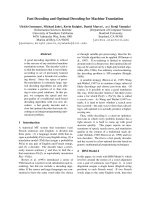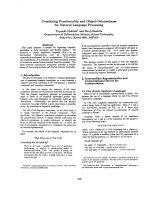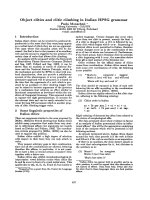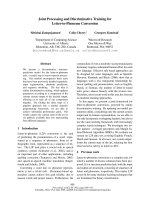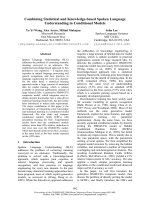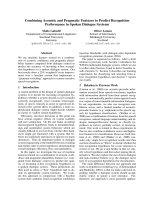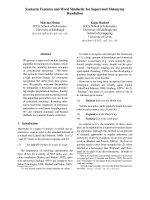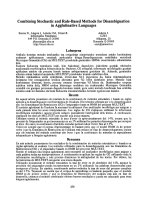Báo cáo khoa học: "Combining Trigram-based and Feature-based Methods for Context-Sensitive Spelling Correction" docx
Bạn đang xem bản rút gọn của tài liệu. Xem và tải ngay bản đầy đủ của tài liệu tại đây (729.13 KB, 8 trang )
Combining Trigram-based and Feature-based Methods for
Context-Sensitive Spelling Correction
Andrew R. Golding and Yves Schabes
Mitsubishi Electric Research Laboratories
201 Broadway
Cambridge, MA 02139
{golding, schabes}@merl,
com
Abstract
This paper addresses the problem of cor-
recting spelling errors that result in valid,
though unintended words (such as
peace
and
piece,
or
quiet
and
quite)
and also
the problem of correcting particular word
usage errors (such as
amount
and
num-
ber,
or
among
and
between).
Such cor-
rections require contextual information and
are not handled by conventional spelling
programs such as Unix
spell.
First, we
introduce a method called
Trigrams
that
uses part-of-speech trigrams to encode the
context. This method uses a small num-
ber of parameters compared to previous
methods based on word trigrams. How-
ever, it is effectively unable to distinguish
among words that have the same part
of speech. For this case, an alternative
feature-based method called
Bayes
per-
forms better; but Bayes is less effective
than Trigrams when the distinction among
words depends on syntactic constraints. A
hybrid method called
Tribayes
is then in-
troduced that combines the best of the pre-
vious two methods. The improvement in
performance of Tribayes over its compo-
nents is verified experimentally. Tribayes is
also compared with the grammar checker in
Microsoft Word, and is found to have sub-
stantially higher performance.
1 Introduction
Spelling correction has become a very common tech-
nology and is often not perceived as a problem
where progress can be made. However, conventional
spelling checkers, such as Unix
spell,
are concerned
only with spelling errors that result in words that
cannot be found in a word list of a given language.
One analysis has shown that up to 15% of spelling
errors that result from elementary typographical er-
rors (character insertion, deletion, or transposition)
yield another valid word in the language (Peterson,
1986). These errors remain undetected by tradi-
tional spelling checkers. In addition to typographical
errors, words that can be easily confused with each
other (for instance, the homophones
peace
and
piece)
also remain undetected. Recent studies of actual ob-
served spelling errors have estimated that overall,
errors resulting in valid words account for anywhere
from 25% to over 50% of the errors, depending on
the application (Kukich, 1992).
We will use the term
context-sensitive spelling cor-
rection
to refer to the task of fixing spelling errors
that result in valid words, such as:
(1) * Can I have a
peace
of cake?
where
peace
was typed when
piece
was intended.
The task will be cast as one of lexical disambigua-
tion: we are given a predefined collection of
confu-
sion sets,
such as
{peace,piece}, {than, then},
etc.,
which circumscribe the space of spelling errors to
look for. A confusion set means that each word
in the set could mistakenly be typed when another
word in the set was intended. The task is to predict,
given an occurrence of a word in one of the confusion
sets, which word in the set was actually intended.
Previous work on context-sensitive spelling cor-
rection and related lexical disambiguation tasks has
its limitations. Word-trigram methods (Mays, Dam-
erau, and Mercer, 1991) require an extremely large
body of text to train the word-trigram model; even
with extensive training sets, the problem of sparse
data is often acute. In addition, huge word-trigram
tables need to be available at run time. More-
over, word trigrams are ineffective at capturing long-
distance properties such as discourse topic and tense.
Feature-based approaches, such as Bayesian clas-
sifters (Gale, Church, and Yarowsky, 1993), deci-
sion lists (Yarowsky, 1994), and Bayesian hybrids
(Golding, 1995), have had varying degrees of suc-
cess for the problem of context-sensitive spelling
correction. However, we report experiments that
show that these methods are of limited effective-
ness for cases such as
{their, there, they're}
and
{than, then},
where the predominant distinction to
be made among the words is syntactic.
71
Confusion set Train Test Most freq. Base
their, there, they're 3265 850
than, then 2096 514
its, it's 1364 366
your, you're 750 187
begin, being 559 146
passed, past 307 74
quiet, quite 264 66
weather, whether 239 61
accept, except 173 50
lead, led 173 49
cite, sight, site 115 34
principal, principle 147 34
raise, rise 98 39
affect, effect 178 49
peace, piece 203 50
country, county 268 62
amount, number 460 123
among, between 764 186
their 56.8
than 63.4
its 91.3
your 89.3
being 93.2
past 68.9
quite 83.3
whether 86.9
except 70.0
led 46.9
sight 64.7
principle 58.8
rise 64.1
effect 91.8
peace 44.0
country 91.9
number 71.5
between 71.5
Table 1: Performance of the baseline method for 18 confusion sets. "Train" and "Test" give the number
of occurrences of any word in the confusion set in the training and test corpora. "Most freq." is the word
in the confusion set that occurred most often in the training corpus.
"Base"
is the percentage of correct
predictions of the baseline system on the test corpus.
In this paper, we first introduce a method called
Trigrams
that uses part-of-speech trigrams to en-
code the context. This method greatly reduces the
number of parameters compared to known methods,
which are based on
word
trigrams. This method
also has the advantage that training can be done
once and for all, and quite manageably, for all con-
fusion sets; new confusion sets can be added later
without any additional training. This feature makes
Trigrams a very easily expandable system.
Empirical evaluation of the trigram method
demonstrates that it performs well when the words
to be discriminated have different parts of speech,
but poorly when they have the same part of speech.
In the latter case, it is reduced to simply guessing
whichever word in the confusion set is the most com-
mon representative of its part-of-speech class.
We consider an alternative method,
Bayes, a
Bayesian hybrid method (Golding, 1995), for the
case where the words have the same part of speech.
We confirm experimentally that Bayes and Trigrams
have complementary performance, Trigrams being
better when the words in the confusion set have dif-
ferent parts of speech, and Bayes being better when
they have the same part of speech. We introduce
a hybrid method,
Tribayes,
that exploits this com-
plementarity by invoking each method when it is
strongest. Tribayes achieves the best accuracy of
the methods under consideration in all situations.
To evaluate the performance of Tribayes with re-
spect to an external standard, we compare it to the
grammar checker in Microsoft Word. Tribayes is
found to have substantially higher performance.
This paper is organized as follows: first we present
the methodology used in the experiments. We then
discuss the methods mentioned above, interleaved
with experimental results. The comparison with Mi-
crosoft Word is then presented. The final section
concludes.
2 Methodology
Each method will be described in terms of its op-
eration on a single confusion set C = {Wl, , w,};
that is, we will say how the method disambiguates
occurrences of words wl through wn. The methods
handle multiple confusion sets by applying the same
technique to each confusion set independently.
Each method involves a training phase and a
test phase. We trained each method on 80%
(randomly selected) of the Brown corpus (Ku6era
and Francis, 1967) and tested it on the remain-
ing 20%. All methods were run on a collection of
18 confusion sets, which were largely taken from
the list of "Words Commonly Confused" in the
back of Random House (Flexner, 1983). The con-
fusion sets were selected on the basis of being
frequently-occurring in Brown, and representing a
variety of types of errors, including homophone con-
fusions (e.g.,
{peace, piece})
and grammatical mis-
takes (e.g.,
{among, between}).
A few confusion sets
not in Random House were added, representing ty-
pographical errors (e.g.,
{begin, being}).
The confu-
sion sets appear in Table 1.
72
3 Baseline
As an indicator of the difficulty of the task, we com-
pared each of the methods to the method which ig-
nores the context in which the word occurred, and
just guesses based on the priors.
Table 1 shows the performance of the baseline
method for the 18 confusion sets.
4 Trigrams
Mays, Damerau, and Mercer (1991) proposed a
word-trigram method for context-sensitive spelling
correction based on the noisy channel model. Since
this method is based on word trigrams, it requires an
enormous training corpus to fit all of these parame-
ters accurately; in addition, at run time it requires
extensive system resources to store and manipulate
the resulting huge word-trigram table.
In contrast, the method proposed here uses part-
of-speech trigrams. Given a target occurrence of a
word to correct, it substitutes in turn each word in
the confusion set into the sentence. Por each substi-
tution, it calculates the probability of the resulting
sentence. It selects as its answer the word that gives
the highest probability.
More precisely, assume that the word wh occurs
in a sentence
W = wl Wk wn,
and that w~ is a
word we are considering substituting for it, yielding
sentence W I. Word w~ is then preferred over
wk
iff
P(W') > P(W),
where
P(W)
and
P(W')
are the
probabilities of sentences W and W f respectively. 1
We calculate
P(W)
using the tag sequence of W as
an intermediate quantity, and summing, over all pos-
sible tag sequences, the probability of the sentence
with that tagging; that is:
P(W) = ~ P(W, T)
T
where T is a tag sequence for sentence W.
The above probabilities are estimated as is tra-
ditionally done in trigram-based part-of-speech tag-
ging (Church, 1988; DeRose, 1988):
P(W,T) = P(WIT)P(T )
(1)
= HP(wi[ti)
HP(t, lt,_2t,_l)(2)
i i
where
T = tl tn,
and
P(ti]tl-2ti-1)
is the prob a-
bility of seeing a part-of-speech tag
tl
given the two
preceding part-of-speech tags
ti-2
and ti-1. Equa-
tions 1 and 2 will also be used to tag sentences
W and W ~ with their most likely part-of-speech se-
quences. This will allow us to determine the tag that
1To enable fair comparisons between sequences of dif-
ferent length (as when considering
maybe
and
may be),
we actually compare the per-word geometric mean of the
sentence probabilities. Otherwise, the shorter sequence
will usually be preferred, as shorter sequences tend to
have higher probabilities than longer ones.
would be assigned to each word in the confusion set
when substituted into the target sentence.
Table 2 gives the results of the trigram method
(as well as the Bayesian method of the next section)
for the 18 confusion sets. 2 The results are broken
down into two cases: "Different tags" and "Same
tags". A target occurrence is put in the latter iff all
words in the confusion set would have the same tag
when substituted into the target sentence. In the
"Different tags" condition, Trigrams generally does
well, outscoring Bayes for all but 3 confusion sets
and in each of these cases, making no more than 3
errors more than Bayes.
In the "Same tags" condition, however, Trigrams
performs only as well as Baseline. This follows from
Equations 1 and 2: when comparing
P(W)
and
P(WI),
the dominant term corresponds to the most
likely tagging; and in this term, if the target word
wk and its substitute w~ have the same tag t, then
the comparison amounts to comparing
P(wk
[/) and
P(w~lt ).
In other words, the decision reduces to
which of the two words,
Wk
and w~, is the more
common representative of part-of-speech class
t. 3
5 Bayes
The previous section showed that the part-of-speech
trigram method works well when the words in the
confusion set have different parts of speech, but es-
sentially cannot distinguish among the words if they
have the same part of speech. In this case, a more
effective approach is to learn
features
that char-
acterize the different contexts in which each word
tends to occur. A number of feature-based methods
have been proposed, including Bayesian classifiers
(Gale, Church, and Yarowsky, 1993), decision lists
(Yarowsky, 1994), Bayesian hybrids (Golding, 1995),
and, more recently, a method based on the Winnow
multiplicative weight-updating algorithm (Golding
and Roth, 1996). We adopt the Bayesian hybrid
method, which we will call
Bayes,
having experi-
mented with each of the methods and found Bayes to
be among the best-performing for the task at hand.
This method has been described elsewhere (Golding,
1995) and so will only be briefly reviewed here; how-
ever, the version used here uses an improved smooth-
ing technique, which is mentioned briefly below.
~In the experiments reported here, the trigram
method was run using the tag inventory derived from the
Brown corpus, except that a handful of common func-
tion words were tagged as themselves, namely:
except,
than, then, to, too, and whether.
3 In a few cases, however, Trig'rams does not get ex-
actly the same score as Baseline. This can happen when
the words in the confusion set have more than one tag
in common; e.g., for
(affect, effect},
the words can both
be norms or verbs. Trigrams may then choose differ-
ently when the words are tagged as nouns versus verbs,
whereas Baseline makes the same choice in all cases.
73
Confusion
set
their, there, they're
than, then
its, it's
your, you're
begin, being
passed, past
quiet, quite
weather, whether
accept, except
lead, led
cite, sight, site
principal, principle
raise, rise
affect, effect
peace, piece
country, county
amount, number
among, between
Break-
down
I00
100
100
100
100
I00
100
100
100
I00
I00
29
8
6
2
0
0
0
Different
tags
System scores
Base T B
56.8 97.6 94.4
63.4 94.9 93.2
91.3 98.1 95.9
89.3 98.9 89.8
93.2 97.3 91.8
68.9 95.9 89.2
83.3 95.5 89.4
86.9 93.4 96.7
70.0 82.0 88.0
46.9 83.7 79.6
64.7 70.6 73.5
0.0 100.0 70.0
100.0 100.0 100.0
100.0 100.0 66.7
0.0 100.0 100.0
Break-
down
0
0
0
.0
0
0
0
0
0
0
0
71
92
94
98
100
100
100
Same tags
System scores
Base T B
83.3 83.3 91.7
61.1 61.1 72.2
91.3 93.5 97.8
44.9 42.9 89.8
91.9 91.9 85.5
71.5 73.2 82.9
71.5 71.5 75.3
Table 2: Performance of the component methods, Baseline (Base), Trigrams (T), and Bayes (B). System
scores are given as percentages of correct predictions. The results are broken down by whether or not all
words in the confusion set would have the same tagging when substituted into the target sentence. The
"Breakdown" columns show the percentage of examples that fall under each condition.
Bayes uses two types of features: context words
and collocations. Context-word features test for the
presence of a particular word within +k words of
the target word; collocations test for a pattern of
up to ~ contiguous words and/or part-of-speech tags
around the target word. Examples for the confusion
set
{dairy, diary}
include:
(2)
milk
within +10 words
(3)
in
POSS-DET
where (2) is a context-word feature that tends to im-
ply
dairy,
while (3) is a collocation implying
diary.
Feature (3) includes the tag POSS-I)ET for possessive
determiners
(his, her,
etc.), and matches, for exam-
ple, the sequence
in his 4
in:
(4) He made an entry in his
diary.
Bayes learns these features from a training corpus
of correct text. Each time a word in the confusion
set occurs in the corpus, Bayes proposes every fea-
ture that matches the context one context-word
feature for every distinct word within +k words of
the target word, and one collocation for every way of
4A tag is taken to match a word in the sentence iff
the tag is a member of the word's set of possible part-of-
speech tags. Tag sets are used, rather than actual tags,
because it is in general impossible to tag the sentence
uniquely at spelling-correction time, as the identity of
the target word has not yet been established.
expressing a pattern of up to ~ contiguous elements.
After working through the whole training corpus,
Bayes collects and returns the set of features pro-
posed. Pruning criteria may be applied at this point
to eliminate features that are based on insufficient
data, or that are ineffective at discriminating among
the words in the confusion set.
At run time, Bayes uses the features learned dur-
ing training to correct the spelling of target words.
Let jr be the set of features that match a particu-
lar target occurrence. Suppose for a moment that we
were applying a
naive
Bayesian approach. We would
then calculate the probability that each word wi in
the confusion set is the correct identity of the target
word, given that we have observed features 9 r, using
Bayes' rule with the independence assumption:
P(w,l~')
= P(flw,) P(5)
where each probability on the right-hand side is cal-
culated by a maximum-likelihood estimate (MLE)
over the training set. We would then pick as our an-
swer the wi with the highest
P(wiI.T" ).
The method
presented here differs from the naive approach in
two respects: first, it does not assume independence
among features, but rather has heuristics for de-
tecting strong dependencies, and resolving them by
deleting features until it is left with a reduced set .T "~
74
of (relatively) independent features, which are then
used in place of ~" in the formula above. Second,
to estimate the
P(flwi)
terms, rather than using a
simple MLE, it performs
smoothing
by interpolat-
ing between the MLE of
P(flwi)
and the MLE of
the unigram probability,
P(f).
These enhancements
greatly improve the performance of Bayes over the
naive Bayesian approach.
The results of Bayes are shown in Table 2. 5 Gener-
ally speaking, Bayes does worse than Trigrams when
the words in the confusion set have different parts
of speech. The reason is that, in such cases, the pre-
dominant distinction to be made among the words
is
syntactic;
and the trigram method, which brings
to bear part-of-speech knowledge for the whole sen-
tence, is better equipped to make this distinction
than Bayes, which only tests up to two syntactic el-
ements in its collocations. Moreover, Bayes' use of
context-word features is arguably misguided here, as
context words pick up differences in topic and tense,
which are irrelevant here, and in fact tend to degrade
performance by detecting spurious differences. In a
few cases, such as
{begin, being},
this effect is enough
to drive Bayes slightly below Baseline. 6
For the condition where the words have the same
part of speech, Table 2 shows that Bayes almost al-
ways does better than Trigrams. This is because, as
discussed above, Trigrams is essentially acting like
Baseline in this condition. Bayes, on the other hand,
learns features that allow it to discriminate among
the particular words at issue, regardless of their part
of speech. The one exception is
{country, county},
for which Bayes scores somewhat below Baseline.
This is another case in which context words actu-
ally hurt Bayes, as running it without context words
again improved its performance to the Baseline level.
6 Tribayes
The previous sections demonstrated the complemen-
tarity between Trigrams and Bayes: Trigrams works
best when the words in the confusion set do not all
have the same part of speech, while Bayes works best
when they do. This complementarity leads directly
to a hybrid method,
Tribayes,
that gets the best of
each. It applies Trigrams first; in the process, it as-
certains whether all the words in the confusion set
would have the same tag when substituted into the
5For the experiments reported here, Bayes was con-
figured as follows: k (the half-width of the window of
context words) was set to 10; £ (the maximum length of a
collocation) was set to 2; feature strength was measured
using the reliability metric; pruning of collocations at
training time was enabled; and pruning of context words
was minimal context words were pruned only if they
had fewer than 2 occurrences or non-occurrences.
eWe confirmed this by running Bayes without context
words (i.e., with collocations only). Its performance was
then always at or above Baseline.
75
target sentence. If they do not, it accepts the answer
provided by Trigrams; if they do, it applies Bayes.
Two points about the application of Bayes in the
hybrid method: first, Bayes is now being asked to
distinguish among words only when they have the
same part of speech. It should be trained accord-
ingly that is, only on examples where the words
have the same part of speech. The Bayes component
of the hybrid will therefore be trained on a subset
of the examples that would be used for training the
stand-alone version of Bayes.
The second point about Bayes is that, like Tri-
grams, it sometimes makes uninformed decisions
decisions based only on the priors. For Bayes, this
happens when none of its features matches the target
occurrence. Since, for now, we do not have a good
"third-string" algorithm to call when both Trigrams
and Bayes fall by the wayside, we content ourselves
with the guess made by Bayes in such situations.
Table 3 shows the performance of Tribayes com-
pared to its components. In the "Different tags" con-
dition, Tribayes invokes Trigrams, and thus scores
identically. In the "Same tags" condition, Tribayes
invokes Bayes. It does not necessarily score the
same, however, because, as mentioned above, it is
trained on a subset of the examples that stand-alone
Bayes is trained on. This can lead to higher or lower
performance higher because the training exam-
ples are more homogeneous (representing only cases
where the words have the same part of speech); lower
because there may not be enough training examples
to learn from. Both effects show up in Table 3.
Table 4 summarizes the overall performance of all
methods discussed. It can be seen that Trigrams
and Bayes each have their strong points. Tribayes,
however, achieves the maximum of their scores, by
and large, the exceptions being due to cases where
one method or the other had an unexpectedly low
score (discussed in Sections 4 and 5). The confusion
set
{raise, rise}
demonstrates (albeit modestly) the
ability of the hybrid to outscore
both
of its compo-
nents, by putting together the performance of the
better component for both conditions.
7 Comparison with Microsoft Word
The previous section evaluated the performance of
Tribayes with respect to its components, and showed
that it got the best of both. In this section,
we calibrate this overall performance by compar-
ing Tribayes with Microsoft Word (version 7.0), a
widely used word-processing system whose grammar
checker represents the state of the art in commercial
context-sensitive spelling correction.
Unfortunately we cannot evaluate Word using
"prediction accuracy" (as we did above), as we do
not always have access to the system's predictions
sometimes it
suppresses
its predictions in an effort
to filter out the bad ones. Instead, in this section
Confusion set Different tags Same tags
Break- System scores Break- System scores
down T TB down B TB
their, there, they're 100 97.6 97.6 0
than, then 100 94.9 94.9 0
its, it's 100 98.1 98.1 0
your, you're 100 98.9 98.9 0
begin, being 100 97.3 97.3 0
passed, past 100 95.9 95.9 0
quiet, quite 100 95.5 95.5 0
weather, whether 100 93.4 93.4 0
accept, except 100 82.0 82.0 0
lead, led 100 83.7 83.7 0
cite, sight, site 100 70.6 70.6 0
principal, principle 29 100.0 100.0 71 91.7 83.3
raise, rise 8 100.0 100.0 92 72.2 75.0
affect, effect 6 100.0 100.0 94 97.8 95.7
peace, piece 2 100.0 100.0 98 89.8 89.8
country, county 0 100 85.5 85.5
amount, number 0 100 82.9 82.9
among, between 0 100 75.3 75.3
Table 3: Performance of the hybrid method, Tribayes (TB), as compared with Trigrams (T) and Bayes (B).
System scores are given as percentages of correct predictions. The results are broken down by whether or
not all words in the confusion set would have the same tagging when substituted into the target sentence.
The "Breakdown" columns give the percentage of examples under each condition.
Confusion set System scores
Base T B TB
their, there, they're
than, then
its, it's
your, you're
begin, being
passed, past
quiet, quite
weather, whether
accept, except
lead, led
cite, sight, site
principal, principle
raise, rise
affect, effect
peace, piece
country, county
amount, number
among, between
56.8 97.6 94.4 97.6
63.4 94.9 93.2 94.9
91.3 98.1 95.9 98.1
89.3 98.9 89.8 98.9
93.2 97.3 91.8 97.3
68.9 95.9 89.2 95.9
83.3 95.5 89.4 95.5
86.9 93.4 96.7 93.4
70.0 82.0 88.0 82.0
46.9 83.7 79.6 83.7
64.7 70.6 73.5 70.6
58.8 88.2 85.3 88.2
64.1 64.1 74.4 76.9
91.8 93.9 95.9 95.9
44.0 44.0 90.0 90.0
91.9 91.9 85.5 85.5
71.5 73.2 82.9 82.9
71.5 71.5 75.3 75.3
Table 4: Overall performance of all methods: Baseline (Base), Trigrams
System scores are given as percentages of correct predictions.
(T), Bayes (B), and Tribayes (TB).
76
we will use two parameters to evaluate system per-
formance: system accuracy when tested on
correct
usages of words, and system accuracy on
incorrect
usages. Together, these two parameters give a com-
plete picture of system performance: the score on
correct usages measures the system's rate of false
negative errors (changing a right word to a wrong
one), while the score on incorrect usages measures
false positives (failing to change a wrong word to a
right one). We will not attempt to combine these two
parameters into a single measure of system "good-
ness", as the appropriate combination varies for dif-
ferent users, depending on the user's typing accuracy
and tolerance of false negatives and positives.
The test sets for the correct condition are the same
ones used earlier, based on 20% of the Brown corpus.
The test sets for the incorrect condition were gener-
ated by corrupting the correct test sets; in particu-
lar, each correct occurrence of a word in the confu-
sion set was replaced, in turn, with each other word
in the confusion set, yielding n - 1 incorrect occur-
rences for each correct occurrence (where n is the
size of the confusion set). We will also refer to the
incorrect condition as the
corrupted
condition.
To run Microsoft Word on a particular test set,
we started by disabling error checking for all error
types except those needed for the confusion set at
issue. This was done to avoid confounding effects.
For
{their, there, they're},
for instance, we enabled
"word usage" errors (which include substitutions of
their
for
there,
etc.), but we disabled "contractions"
(which include replacing
they're
with
they are). We
then invoked the grammar checker, accepting every
suggestion offered. Sometimes errors were pointed
out but no correction given; in such cases, we
skipped over the error. Sometimes the suggestions
led to an infinite loop, as with the sentence:
(5) Be sure it's out when you leave.
where the system alternately suggested replacing
it's
with
its
and vice versa. In such cases, we accepted
the first suggestion, and then moved on.
Unlike Word, Tribayes, as presented above, is
purely a predictive system, and never suppresses its
suggestions. This is somewhat of a handicap in the
comparison, as Word can achieve higher scores in the
correct condition by suppressing its weaker sugges-
tions (albeit at the cost of lowering its scores in the
corrupted condition). To put Tribayes on an equal
footing, we added a postprocessing step in which it
uses
thresholds
to decide whether to suppress its sug-
gestions. A suggestion is allowed to go through iff
the ratio of the probability of the word being sug-
gested to the probability of the word that appeared
originally in the sentence is above a threshold. The
probability associated with each word is the per-
word sentence probability in the case of Trigrams,
or the conditional probability
P(wi[~)
in the case
of Bayes. The thresholds are set in a preprocessing
77
phase based on the training set (80% of Brown, in
our case). A single tunable parameter controls how
steeply the thresholds are set; for the study here, this
parameter was set to the middle of its useful range,
providing a fairly neutral balance between reducing
false negatives and increasing false positives.
The results of Word and Tribayes for the 18 confu-
sion sets appear in Table 5. Six of the confusion sets
(marked with asterisks in the table) are not handled
by Word; Word's scores in these cases are 100% for
the correct condition and 0% for the corrupted con-
dition, which are the scores one gets by never mak-
ing a suggestion. The opposite behavior
always
suggesting a different word would result in scores
of 0% and 100% (for a confusion set of size 2). Al-
though this behavior is never observed in its extreme
form, it is a good approximation of Word's behavior
in a few cases, such as
{principal, principle},
where
it scores 12% and 94%. In general, Word achieves
a high score in either the correct or the corrupted
condition, but not both at once.
Tribayes compares quite favorably with Word in
this experiment. In both the correct and corrupted
conditions, Tribayes' scores are mostly higher (often
by a wide margin) or the same as Word's; in the
cases where they are lower in one condition, they
are almost always considerably higher in the other.
The one exception is
{raise, rise},
where Tribayes
and Word score about the same in both conditions.
8 Conclusion
Spelling errors that result in valid, though unin-
tended words, have been found to be very common
in the production of text. Such errors were thought
to be too difficult to handle and remain undetected
in conventional spelling checkers. This paper in-
troduced Trigrams, a part-of-speech trigram-based
method, that improved on previous trigram meth-
ods, which were word-based, by greatly reducing
the number of parameters. The method was sup-
plemented by Bayes, a method that uses context
features to discriminate among the words in the
confusion set. Trigrams and Bayes were shown to
have complementary strengths. A hybrid method,
Tribayes, was then introduced to exploit this com-
plementarity by applying Trigrams when the words
in the confusion set do not have the same part of
speech, and Bayes when they do. Tribayes thereby
gets the best of both methods, as was confirmed ex-
perimentally. Tribayes was also compared with the
grammar checker in Microsoft Word, and was found
to have substantially higher performance.
Tribayes is being used as part of a grammar-
checking system we are currently developing. We
are presently working on elaborating the system's
threshold model; scaling up the number of confusion
sets that can be handled efficiently; and acquiring
confusion sets (or confusion matrices) automatically.
Confusion set Tribayes Microsoft Word
Correct Corrupted Correct Corrupted
their, there, they're
than, then
its, it's
your, you're
begin, being
passed, past
quiet, quite
weather, whether
accept, except
lead, led
cite, sight, site
principal, principle
rMse, rise
affect, effect
peace, piece
country, county
amount, number
among, between
99.4 87.6
97.9 85.8
99.5 92.1
98.9 98.4
100.0 84.2
100.0 92.4
100.0 72.7
100.0 65.6
90.0 70.0
87.8 81.6
100.0 35.3
94.1 73.5
92.3 48.7
98.0 93.9
96.0 74.0
90.3 80.6
91.9 68.3
88.7 54.8
98.8 59.8
100.0 22.2
96.2 73.0
98.9 79.1
100.0 * 0.0 *
37.8 86.5
100.0 * 0.0 *
100.0 * 0.0 *
74.0 36.0
100.0 * 0.0 *
17.6 66.2
11.8 94.1
92.3 51.3
100.0 77.6
36.0 88.0
100.0
* 0.0 *
100.0 * 0.0 *
97.8 0.0
Table 5: Comparison of Tribayes with Microsoft Word. System scores are given for two test sets, one con-
taining correct usages, and the other containing incorrect (corrupted) usages. Scores are given as percentages
of correct answers. Asterisks mark confusion sets that are not handled by Microsoft Word.
References
Church, Kenneth Ward. 1988. A stochastic parts
program and noun phrase parser for unrestricted
text. In Second Conference on Applied Natural
Language Processing, pages 136-143, Austin, TX.
DeRose, S.J. 1988. Grammatical category disam-
biguation by statistical optimization. Computa-
tional Linguistics, 14:31-39.
Flexner, S. B., editor. 1983. Random House
Unabridged Dictionary. Random House, New
York. Second edition.
Gale, William A., Kenneth W. Church, and David
Yarowsky. 1993. A method for disambiguating
word senses in a large corpus. Computers and the
Humanities, 26:415-439.
Golding, Andrew P~. and Dan Roth. 1996. Apply-
ing Winnow to context-sensitive spelling correc-
tion. In Lorenza Saitta, editor, Machine Learning:
Proceedings of the 13th International Conference,
Bari, Italy. To appear.
Golding, Andrew R. 1995. A Bayesian hybrid
method for context-sensitive spelling correction.
In Proceedings of the Third Workshop on Very
Large Corpora, pages 39-53, Boston, MA.
Kukich, Karen. 1992. Techniques for automaticMly
correcting words in text. ACM Computing Sur-
veys, 24(4):377-439, December.
78
Kuaera, H. and W. N. Francis. 1967. Computa-
tional Analysis of Present-Day American English.
Brown University Press, Providence, RI.
Mays, Eric, bred J. Damerau, and Robert L. Mercer.
1991. Context based spelling correction. Informa-
tion Processing and Management, 27(5):517-522.
Peterson, James L. 1986. A note on undetected
typing errors. Communications of the ACM,
29(7):633-637, July.
Yarowsky, David. 1994. Decision lists for lexi-
cal ambiguity resolution: Application to accent
restoration in Spanish and French. In Proceedings
of the 32nd Annual Meeting of the Associa-
tion for Computational Linguistics, pages 88-95,
Las Cruces, NM.
